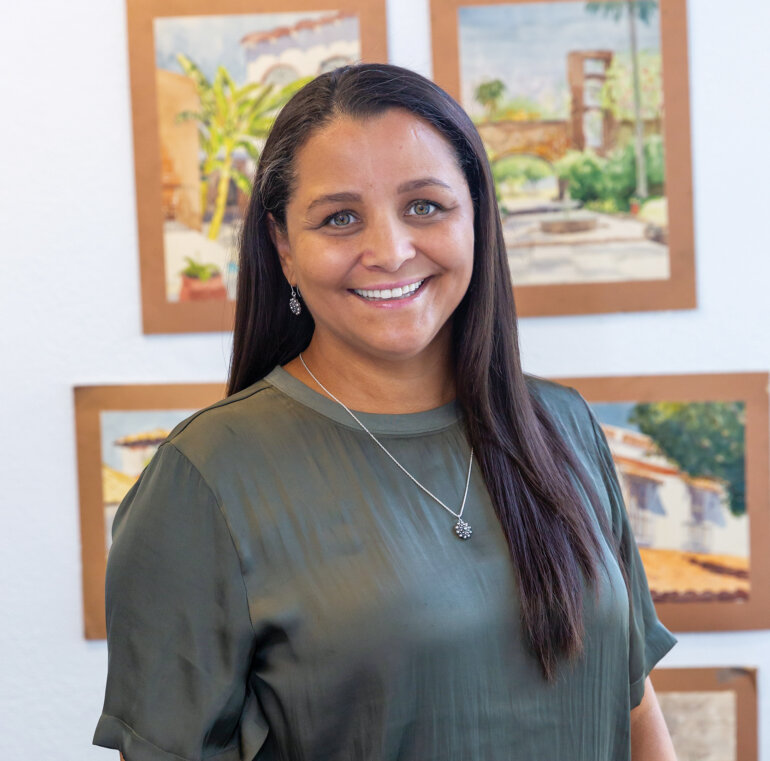Cindy Murillo
Academy Spanish Language Teacher
Related: In Good Company: Gaylynn Nakamatsu
For Academy Spanish Language Teacher Cindy Murillo, instilling an appreciation for diverse cultures is a core part of her teaching philosophy. “The language students are learning in school isn’t just about vocabulary and grammar; it’s a bridge between cultures,” she says.
Murillo’s life journey has had a global scope. Born in Costa Rica, she worked as a nurse before meeting her Canadian husband. They moved for professional and academic opportunities, first to Barcelona, then Vancouver and finally to Hawai‘i, where her husband accepted a position as a professor of psychology at the University of Hawai‘i. Now, after 17 years, Murillo proudly calls Hawai‘i home.
When she’s not in the classroom, you’ll likely find her courtside, cheering on her two children, Sofia Sinnett ’26 and David Sinnett ’32, both avid tennis players.
You are a native Spanish speaker from Costa Rica – how did you wind up being a language teacher in Honolulu?
Yes, I’m Costa Rican, or as we say: “soy tica.” Before I became a Spanish teacher I was a nurse for some time. When we moved to Hawai‘i, I realized that continuing as a nurse would require returning to school and repeating much of my training in English, which was not an easy option with a new baby. During my time traveling the world, I discovered that I loved sharing my language with others. So, I decided to pursue a master’s degree in Spanish literature and education at the University of Hawai‘i – where I taught for four years before joining the faculty at Punahou.
What are some cultural experiences that you incorporate to engage students?
I want my students to experience cultural elements that often don’t appear in textbooks. Music and dance play a big role in my classroom. We’ve danced salsa, merengue and bachata together. Food is another fun way to bring culture into the classroom. My students have cooked gallo pinto, corn tortillas, tacos and even paella. We watch movies and short films related to our lessons, which help them learn not just the language but also the culture.
We’ve also done letter and video exchanges with schools in Galicia and Barcelona. Another project we’ve worked on involves writing children’s books about topics like friendship or sustainability, which we send to underprivileged children in Mexico and Costa Rica. I’ve also taken students to Salamanca, Spain for the past two summers so that they can experience the language and culture first-hand (it’s the longest trip that Punahou students can take part in – 5 weeks).
How do you instill cross-cultural appreciation?
I strive to do this constantly. I have been helping students in various cultural clubs at Punahou, including the Shanti Alliance, Latin & Hispanic Heritage Club and the South Asian Club. I enjoyed the work so much that I proposed organizing a multicultural event with the help of the Shanti Alliance. We worked hard to bring it to life, ensuring that all cultural clubs were involved and that different cultures were represented.
We have run the Punahou Multicultural Celebration for two consecutive years. This year was particularly special because it coincided with a lesson on identity and acceptance in my classroom. That day, I taught my students about Rigoberta Menchú and her fight for human rights. We discussed how she emphasizes the importance of educating children about acceptance and fighting against racism. After participating in the multicultural event, many students reflected on how meaningful it was and suggested organizing more events like it to continue educating others.
What are the unique challenges and rewards of teaching Spanish to high school students?
My goal is for students to not only communicate effectively but also to truly enjoy the language. I encourage them to embrace Spanish in their daily lives – laugh with the language, sing, talk to friends, tell jokes, and make friends from other countries. Most importantly, I remind them that making errors is part of the learning process – the key is to continue communicating and connecting with others.
I always tell them: Learning a second language will open doors for you in the future – as it did for me.

